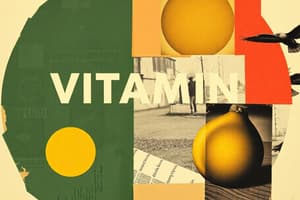Podcast
Questions and Answers
What is the recommended dietary allowance (RDA) of Vitamin K for adults?
What is the recommended dietary allowance (RDA) of Vitamin K for adults?
- 25 IU for women and 30 IU for men
- 30 IU for both men and women
- There are no established requirements (correct)
- 30 IU for men and 25 IU for women
Which of the following statements about Vitamin K deficiency is accurate?
Which of the following statements about Vitamin K deficiency is accurate?
- It may lead to hemorrhage in infants due to the lack of clotting factors. (correct)
- It is rarely observed in infants due to maternal nutrition.
- It is commonly found among adults in developed countries.
- It can cause excessive blood clotting in infants.
What are the main dietary sources of Vitamin K1?
What are the main dietary sources of Vitamin K1?
- Grains and cereals
- Green vegetables like spinach and cabbage (correct)
- Dairy products and meats
- Fruits and nuts
What distinguishes Vitamin K1 from Vitamin K2 structurally?
What distinguishes Vitamin K1 from Vitamin K2 structurally?
Why was Vitamin K initially identified and named?
Why was Vitamin K initially identified and named?
What was the original designation of Vitamin E when it was first discovered?
What was the original designation of Vitamin E when it was first discovered?
Which form of tocopherol is considered the most potent with maximum Vitamin E activity?
Which form of tocopherol is considered the most potent with maximum Vitamin E activity?
What major role does Vitamin E play in the human body?
What major role does Vitamin E play in the human body?
Which food sources are known to be high in Vitamin E?
Which food sources are known to be high in Vitamin E?
How does a deficiency in Vitamin E affect fertility in animals?
How does a deficiency in Vitamin E affect fertility in animals?
Which of the following statements about Vitamin E is false?
Which of the following statements about Vitamin E is false?
What structural feature differentiates various tocopherols?
What structural feature differentiates various tocopherols?
What is the typical human requirement for Vitamin E, according to the content?
What is the typical human requirement for Vitamin E, according to the content?
Flashcards are hidden until you start studying
Study Notes
Vitamins Overview
- Vitamins are essential nutrients that play crucial roles in biological functions.
- Fat-soluble vitamins include Vitamin E and Vitamin K, both vital for various physiological processes.
Vitamin E
- Discovered in vegetable oils and known as the anti-sterility factor due to its link to reproductive health.
- Isolated from wheat germ oil and termed tocopherol; found in corn oil, rice oil, cottonseed oil, soybean, and peanuts, but not in fish liver or olive oil.
- Comprised of tocopherols, derived from 6-hydroxychroman with an isoprenoid side chain.
- α-tocopherol is the most biologically active form, containing three methyl groups at different carbon positions.
Role of Vitamin E
- Functions as an antioxidant, preventing the oxidation of substances and food spoilage.
- Essential for reproduction, positively affecting ectoderm and endoderm (Vitamin A) and mesoderm (Vitamin E) during embryonic development.
- Protects vitamin A from degradation and supports mitochondrial integrity by preserving unsaturated fatty acids in membranes.
Vitamin E Deficiency
- Can lead to sterility, embryo re-absorption, degeneration of testicular germinal epithelium, and production of non-motile sperm.
- Recommended Dietary Allowance (RDA) for Vitamin E:
- Men: 30 IU
- Women: 25 IU
- Pregnant and lactating women: 30 IU
- Infants: 1 to 2.5 IU
- Conversion: 1 IU is equivalent to 1.1 mg of pure compound.
Vitamin K
- Identified when newborn chicks fed artificial diets suffered from fatal hemorrhage due to prolonged blood clotting times.
- Designated as Vitamin K for its role in coagulation and also known as the anti-hemorrhagic factor.
- Exists in two forms: Vitamin K1 (found in green vegetables like spinach and cabbage) and Vitamin K2 (found in fermented fish meal and produced by intestinal bacteria).
- Vitamin K1 is more potent compared to K2.
Role of Vitamin K
- Vital for synthesizing prothrombin, a blood-clotting factor essential for converting fibrinogen to fibrin during clot formation.
- Deficiency in infants results in severe bleeding risks due to the lack of blood clotting capabilities before developing Vitamin K-producing intestinal flora.
- Administration of Vitamin K to pregnant mothers can prevent deficiency in newborns.
Vitamin K Deficiency
- Occurs rarely in adults but can lead to significant bleeding complications in infants.
- There is currently no standardized requirement for Vitamin K consumption established for humans.
Studying That Suits You
Use AI to generate personalized quizzes and flashcards to suit your learning preferences.




